
Wool focussed enterprises boomed during 2017
NSW DPI budgets show that during 2017, wool focussed enterprises boomed due to increases in both fine and medium wool prices. Those fine-wool growers who have invested in genetic gain are likely to have achieved gross margins well above the average.
The 18 micron self-replacing Merino enterprise returned the highest gross margin (GM) at $55.43/DSE, up 55% on the previous year (Figure 1). This equates to $554/ha, assuming a stocking rate of 10 DSE/ha, comparable with cropping gross margins. The next best sheep enterprise was 18 micron wethers, up a whopping 61% on 2016, achieving $51.73/DSE or $517/ha, reflecting higher prices for fine wool in 2017.
Figure 1. NSW sheep enterprise gross margins for 2016 and 2017*
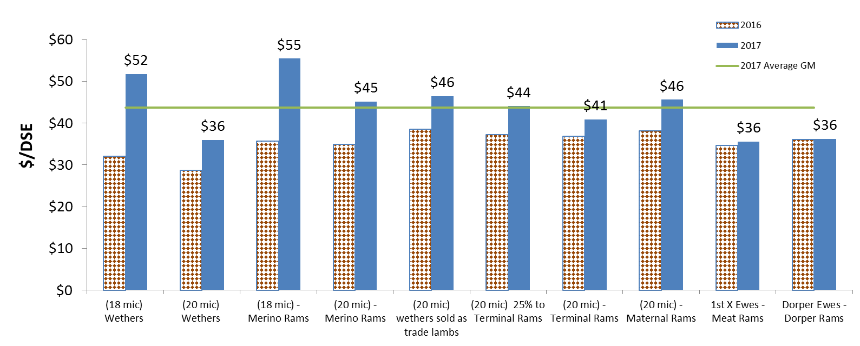
*GM calculations based on average wool and sheep prices from 1 April 2017 to 1 September 2017
Merino-based breeding enterprises (20 micron wool) achieved gains ranging from 29% for ewes solely joined to Merino rams to 11% for ewes solely joined to terminal rams. The difference between the two is primarily due to the increased value of surplus ewe hoggets in the breeding enterprise and the cost of replacement ewes joined to terminal sires.
The 20 micron wethers achieved a 25% increase with a GM of $35.98/DSE, reflecting a lower price rise in medium compared with fine micron wools. The meat sheep enterprises such as 1st Cross ewes joined to terminal rams and the self-replacing Dorper enterprise maintained their GM’s, achieving around $36/DSE.
In 2017, wether enterprises came into their own, as they produced considerably more wool income per DSE (Figure 2).
Figure 2. Proportion of 2017 income from wool and sheep sales
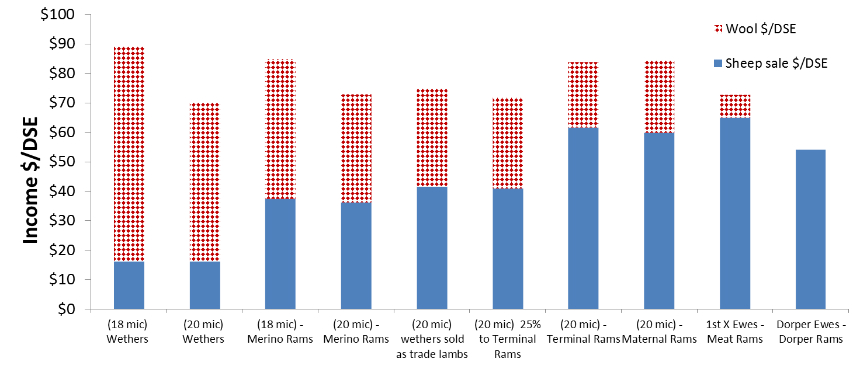
Meat prices were similar to 2016, resulting in a number of enterprises having similar levels of total income per DSE. However, when we look at the cost structures of different enterprises we can see why some enterprises have performed better than others (Figure 3).
For example, the 20 micron ewes joined to terminal rams had the highest costs per DSE, resulting from considerably higher replacement ewe and fodder costs. The 18 micron ewes joined to Merino rams had the second lowest cost per DSE resulting from low replacement (purchasing only rams) and fodder costs. Low costs and high returns resulted in the 18 micron ewe enterprise having the highest GM.
Figure 3. The total variable costs and proportions for different enterprises
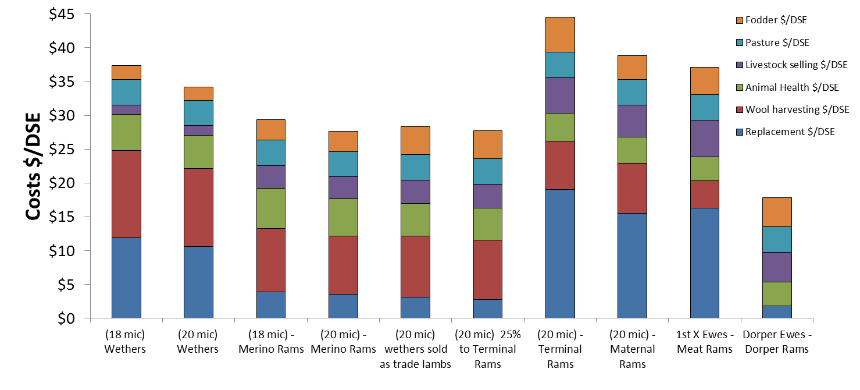
While it is clear that during 2017 wool-focussed enterprises have outperformed others, if we look at the nine year average gross margin, there is very little difference between most enterprises (Figure 4).
Figure 4. Nine year average gross margins 2009-2017
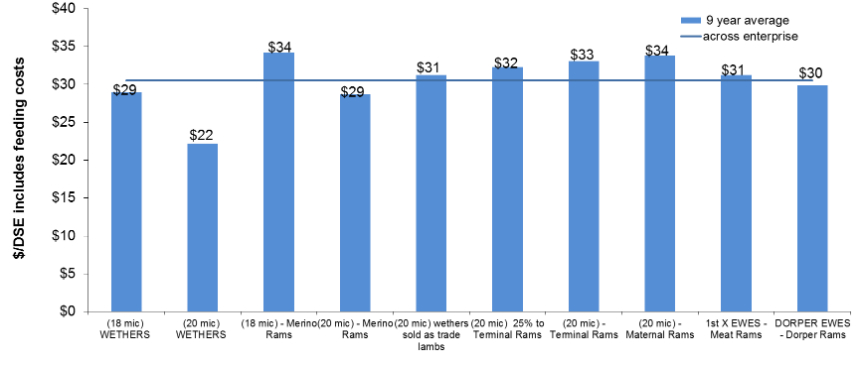
For those producers who have achieved strong genetic gain in their wool enterprises and increased their wool cut while maintaining or reducing micron, their GM gains could be even greater (Figure 5). Genetic gain is achieved by using sound ram buying strategies such as the use of ASBV’s and careful ewe selection.
The base wool cut used in the 18 micron ewe and wether enterprises is 5.10 and 5.54 kg (greasy) respectively, about half a kilogram less than the average wool cut listed in ‘Merino bloodlines: a comparison based on wether trial results 2006 – 2016’ (NSW DPI and AWI). Adult wool prices of $13.16 and $13.40/kg (greasy) were used respectively. Hogget ewe wool was valued at $13.76/kg (greasy) as they were one micron finer. These values account for fleece, skirtings and cardings.
Figure 5. Impact of wool cut and price increases
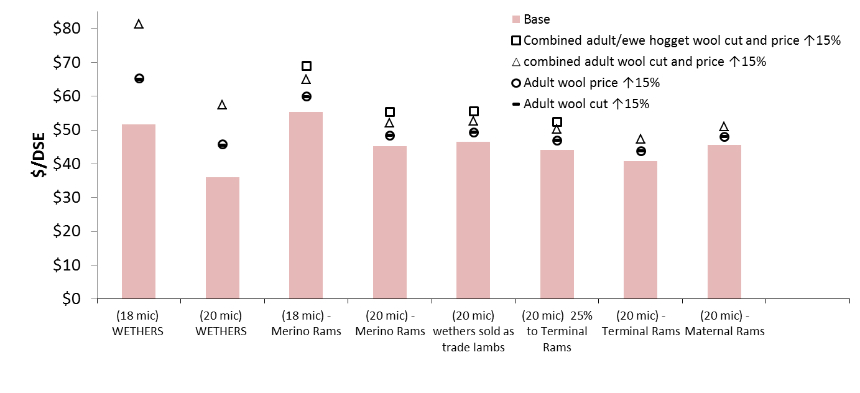
Gross margin calculations published by NSW DPI use sensitivity tables to compare variations in wool performance. For example, a 15% increase in adult wool cut equates to an increase in GM of $4.40/DSE for 18 micron ewes and $13.25/DSE for 18 micron wethers ($59.83 and $64.98/DSE), which is similar to an increase of 15% in adult wool value ($59.94 and $65.32/DSE).
An increase of 15% in both adult wool value and wool cut equates to an increase in gross margin of $9.59/DSE for 18 micron ewes, yielding a total return of $65.02/DSE ($650/ha). The same increases for 18 micron wethers increases gross margin by $29.56/DSE to return a total of $81.29/DSE ($812/ha).
If we account for a similar increase in the hogget wool cut and value, the 18 micron ewe enterprise GM increases a further $4.07/DSE for a total value of $69.09/DSE ($690/ha).
This is double the nine year average for the ewe enterprise and is nearly triple for the 18 micron wethers.
Note
In calculating the 9-year average GMs, there have been slight changes in assumptions. These changes are small and have minimal impact on GM comparisons over time.
GMs only take into account variable costs directly associated with the enterprise and do not take into account capital costs (such as machinery or livestock inventories) or overhead costs.
Each GM is calculated with and without typical supplementary feeding costs, as well as displaying a range of sensitivity tables. The sensitivity tables allow the user to see the impacts changes to key production, income and cost indicators have on GMs. Readers are urged to develop their own enterprise GMs using their actual costs and income.
Hatcher S, Mortimer SI, Wilson BCD and Graham RP. (2016) “Merino bloodlines: a comparison based on wether trial results 2006-2016”. Primefact 1472, NSW Department of Primary Industries.

